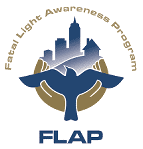Wildlife Damage Management, Internet Center for
Date of this Version
November 2000
Abstract
Hundreds of species of birds migrate at night. If the skies are clear and their path is moonlit these migrants will often fly at high altitudes avoiding any possible obstructions. But the lights of 20th century society can be confusing to them, especially on foggy, rainy nights or when cloud cover is low. Then they may fly directly into tall lighted structures such as skyscrapers, transmission towers, monuments, lighthouses and the like. Where spotlights are shone into the night sky the birds fly "into" the light and become "entrapped", unable or unwilling to fly out again. Eventually, exhausted, they fall to the ground. Some birds are killed outright. Others are stunned and will revive in a couple of hours. Those birds that survive collisions with office towers clustered in a city's downtown core find themselves trapped in a maze of brightly-lit, reflective buildings. Their chances of survival are slim. Feral cats, rats, gulls and other animals learn to take advantage of this easy food source. When people appear on the scene, the disoriented migrants panic and try to take cover in the nearest tree or shrub - whether it's behind a wall of glass or reflected in it. Those birds that do not die upon impact will go into shock, easily falling prey to scavengers or being crushed by unsuspecting feet.



Comments
Published by Fatal Light Awareness Program (FLAP). Used by permission.